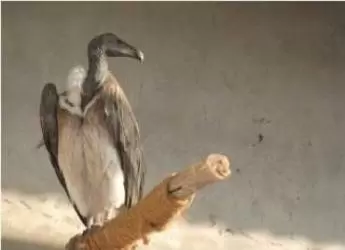Saving Asia’s Vultures from Extinction programme all set to see birds taking wings
15-June-2015
Vol 6 | Issue 24
After a decade of breeding three species of vultures that are listed as critically endangered, the Saving Asia's Vultures from Extinction (Save) programme is all set to take wing with the first release in the wild of the captive-bred birds next year.
Before their release, Save is focusing on creating "safe zones" for them to survive in nature.
 |
|
The SAVE programme is into captive breeding of the critically endangered white-backed, long-billed and slender-billed Gyps vultures (Photo: IANS)
|
At the three Bombay National history Society (BNHS) breeding centres in the country, 42 oriental white-backed, 33 long-billed and 15 slender-billed Gyps vultures have been bred, said Save programme manager Chris Bowden.
"Now we plan to make the first preliminary releases in 2016," he said.
"Of course, the released birds will add significantly to the security of the wild populations," added Bowden, who is also the Royal Society for the Protection of Birds (RSPB) globally threatened species officer.
Studies attribute the massive decline of three species across South Asia to the extensive use of the diclofenac veterinary drug.
The vultures that consumed the carcasses of animals treated with diclofenac died with symptoms of kidney failure. The link was firmly established in 2004.
In 2006, the drug was banned by the Indian government following a demand by ornithologists.
On the success in breeding vultures in captivity, Bowden said: "The Indian vulture species have not been captive-bred before anywhere in the world, but closely-related species have been."
Responding to inbreeding problems being faced by other captive species in India, he said the genetic diversity within the captive stock of the vultures is relatively high.
"But we are still carefully managing the birds and their pairings to avoid close relatives from breeding. Also, when sending birds among centres, this is precisely taken into account. So it's being taken seriously in the captive management."
The Britain-based charitable organisation RSPB is funding three vulture breeding centres in India -- Pinjore in Haryana, Rajabhatkhawa in West Bengal and Rani in Assam, and one in Nepal.
The BNHS breeding centres, including the Vulture Conservation and Breeding Centre here, hold the majority of the world's captive stock of the three threatened vulture species.
The centres possessed 121 oriental white-backed, 72 long-billed and 55 slender-billed, all collected from the wild, besides the captive-bred birds.
Since a breeding pair rears only a single chick per year, Bowden said, "we are breeding more vultures each year."
The first priority of the breeding programme is conserving the birds and genetic diversity.
"It currently appears we may be making real progress ahead of them all disappearing, but it's still very good that we have this security for the species concerned."
The released birds would multiply the wild population. "We will also learn a lot from the process," he added.
Bowden is quite confident about the survival of the vultures in nature after being bred in captivity.
"Yes, we're quite confident that the vultures bred in captivity would be able to survive in nature too. This is based on other work on similar species, especially the Eurasian griffon and the Gyps fulvus in Israel, Italy and Bulgaria."
"The pectoral muscles (of the captive bred birds) are well developed, and international experts have been very pleased by this, as a good sign," he added.
Vibhu Prakash, principal scientist for the vulture breeding centre, based in Pinjore in northern India, said 22 nestlings - seven white-backed, 14 long-billed and one slender-billed - had hatched and successfully fledged.
He said documentation of normal microflora of the Gyps vultures in captivity has been undertaken to ensure the fitness of the birds to be reintroduced in the wild.
Prakash had documented the rapid vulture population decline in the Keoladeo National Park in Rajasthan in 1999.
Almost 99 percent of the white-backed vultures and 97 percent of long-billed vultures had been wiped out.
"Only 200 pairs of the slender-billed vulture are left in the world, primarily in India, Pakistan and Nepal. It's time to save the scavengers from certain extinction through captive breeding," he added.
Spread over five acres of Haryana forest department land in Jodhpur village off the Chandigarh-Shimla highway, the Pinjore breeding centre lies close to the Bir Shikargah Wildlife Sanctuary.
It was set up in 2001 as a vulture care centre with funding from Britain's Darwin's Initiative for Survival of Species fund. At that time, injured vultures were brought for care from Haryana, Rajasthan, Madhya Pradesh, Maharashtra and Gujarat.
It was upgraded to a breeding centre in 2004. - IANS














